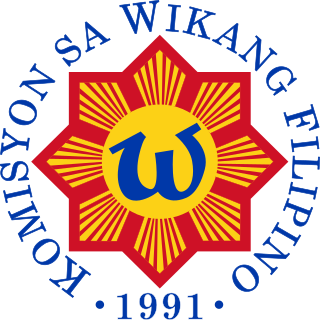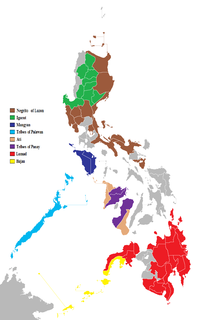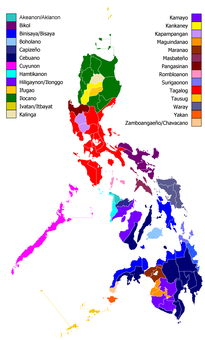
Mindoro is the seventh largest island in the Philippines by land area with a total of 10,571 km2 and with a total population of 1,331,473 as of 2015. It is located off the southwestern coast of Luzon and northeast of Palawan. Mindoro is divided into two provinces: Occidental Mindoro and Oriental Mindoro. San Jose is the largest settlement on the island with a total population of 143,430 inhabitants as of 2015. The southern coast of Mindoro forms the northeastern extremum of the Sulu Sea. Mount Halcon is the highest point on the island, standing at 8,484 feet (2,586 m) above sea level located in Oriental Mindoro. Mount Baco is the island's second highest mountain with an elevation of 8,163 feet (2,488 m), located in the province of Occidental Mindoro.

Oriental Mindoro is a province in the Philippines located on the island of Mindoro under Mimaropa region in Luzon, about 140 kilometres (87 mi) southwest of Manila. The province is bordered by the Verde Island Passage and the rest of Batangas to the north, by Marinduque, Maestre de Campo Island, Tablas Strait and the rest of Romblon to the east, by Semirara and the rest of Caluya Islands, Antique to the south, and by Occidental Mindoro to the west. Calapan, the only city in the island, is the provincial capital.

Occidental Mindoro is a province in the Philippines located in the Mimaropa region. The province occupies the western half of the island of Mindoro. Its capital is Mamburao, but the largest municipality is San Jose. As of 2015, Occidental Mindoro has 487,414 inhabitants.

Puerto Galera, officially the Municipality of Puerto Galera, is a 1st class municipality in the province of Oriental Mindoro, Philippines. According to the 2015 census, it has a population of 36,606 people.

Cordillera Administrative Region (CAR), also known as Cordillera Region, is an administrative region in the Philippines, situated within the island of Luzon. The only landlocked region in the insular country, it is bordered by the Ilocos Region to west and southwest, and by the Cagayan Valley Region to the north, east, and southeast. It is the least populous region in the Philippines, with a population less than that of the City of Manila.

Mangyan is the generic name for the eight indigenous groups found on the island of Mindoro, southwest of the island of Luzon, the Philippines, each with its own tribal name, language, and customs. The total population may be around 280,000, but official statistics are difficult to determine under the conditions of remote areas, reclusive tribal groups and some having little if any outside world contact.

The Komisyon sa Wikang Filipino is the official regulating body of the Filipino language and the official government institution tasked with developing, preserving, and promoting the various local Philippine languages. The commission was established in accordance with the 1987 Constitution of the Philippines.

San Teodoro, officially the Municipality of San Teodoro, is a 4th class municipality in the province of Oriental Mindoro, Philippines. According to the 2015 census, it has a population of 17,904 people.
Mindoro was a province of the Philippines from 1921 until 1950 when it was split into two provinces, Occidental Mindoro and Oriental Mindoro. It is located on Mindoro island, Philippines

The Ati are a Negrito ethnic group in the Visayas, the central portion of the Philippine archipelago. Their small numbers are principally concentrated in the islands of Boracay, Panay and Negros. They are genetically related to other Negrito ethnic groups in the Philippines such as the Aeta of Luzon, the Batak of Palawan, the Agta of the Sierra Madres, and the Mamanwa of Mindanao.
Human rights in the Philippines pertains to the concept, practice of human rights within the Philippine archipelago. The concept of "human rights," in the context of the Philippines, pertains mainly to the civil and political rights of a person living in the Philippines by reason of the 1987 Philippines Constitution. Human rights are a justified set of claims that set moral standards to members of the human race, not exclusive to a specific community or citizenship. Membership in the human race is the sole qualification to obtain these rights. Human rights, unlike area-specific conventions of international laws, are universally justifiable as it pertains to the entire human race, regardless of geographical location.
The Iraya language is a language spoken by Mangyans on the island of Mindoro in the Philippines. Zorc (1974) places the Iraya language within the North Mangyan group of Malayo-Polynesian languages, though Lobel (2013) notes that it shows "considerable differences" to Tadyawan and Alangan, the other languages in this group. There are 6,000 to 8,000 Iraya speakers, and that number is growing. The language status of Iraya is developing, meaning that this language is being put to use in a strong and healthy manner by its speakers, and it also has its own writing system.
The Sangguniang Bayan is the local legislative branch of the municipal governments in the Philippines. It is responsible for passing ordinances and resolutions for the administration of a municipality. Its powers are defined by the Local Government Code, passed by Congress in 1991.

The Philippines consist of numerous upland and lowland indigenous ethnolinguistic groups living in the country, with Austronesians making up the overwhelming majority, while full or partial Australo-Melanesians scattered throughout the archipelago. The highland Austroneians and Australo-Melanesians have co-existed with their lowland Austronesian kin and neighbor groups for thousands of years in the Philippine archipelago. The primary difference is that they were not absorbed by centuries of Spanish and United States colonization of the Philippines, and in the process have retained their customs and traditions. This is mainly due to the rugged inaccessibility of the mountains and established headhunting and warrior cultures, which discouraged Spanish and American colonizers from coming into contact with the highlanders.
Edwin Gariguez is a Filipino religious leader and environmentalist. He was awarded the Goldman Environmental Prize in 2012, for his voicing of protests on behalf of indigenous communities against large scale mining projects in the Philippines.

Ethnic issues in the Philippines are multifarious and emerged in various portions of the history of people, institutions and territories coinciding to that of the present-day Philippines.
Indigenous People's Rights Act of 1997 (IPRA) is a legislation that recognize and promote all the rights of Indigenous Cultural Communities/Indigenous Peoples of the Philippines
Ancestral domain or ancestral lands refers to the lands, territories and resources of indigenous peoples, particularly in the Asia-Pacific region. The term differs from indigenous land rights, Aboriginal title or Native Title by directly indicating relationship to land based on ancestry, while domain indicates relationships beyond material lands and territories, including spiritual and cultural aspects that may not be acknowledged in land titles and legal doctrine about trading ownership.
Intangible cultural heritage (ICH) includes traditions and living expressions that are passed down from generation to generation within a particular community.
Ginaw Bilog was a Filipino poet who was recognized as a National Living Treasure by the Philippine government.










